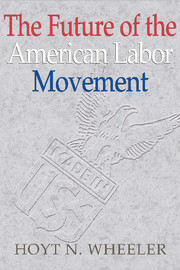Book contents
- Frontmatter
- Contents
- Foreword
- Introduction by Lynn R. Williams
- 1 A Future for the American Labor Movement?
- 2 Industrial Relations in a Time of Change
- 3 A Survey of American Union Strategies
- 4 The Old Reformist Unionism: The Noble Order of the Knights of Labor
- 5 The New Reformist Unionism: CAFE
- 6 A New Version of an Old Reformist Strategy: Employee Ownership
- 7 Social Democratic Unionism in Action: Strategies of European Trade Unions
- 8 A New Twist and TURN on Social Democratic Unionism: Unions and Regional Economic Development
- 9 A Labor Movement for the Twenty-First Century
- Appendix: Interview with John J. Sweeney, President, AFL-CIO
- References
- Index
4 - The Old Reformist Unionism: The Noble Order of the Knights of Labor
Published online by Cambridge University Press: 06 July 2010
- Frontmatter
- Contents
- Foreword
- Introduction by Lynn R. Williams
- 1 A Future for the American Labor Movement?
- 2 Industrial Relations in a Time of Change
- 3 A Survey of American Union Strategies
- 4 The Old Reformist Unionism: The Noble Order of the Knights of Labor
- 5 The New Reformist Unionism: CAFE
- 6 A New Version of an Old Reformist Strategy: Employee Ownership
- 7 Social Democratic Unionism in Action: Strategies of European Trade Unions
- 8 A New Twist and TURN on Social Democratic Unionism: Unions and Regional Economic Development
- 9 A Labor Movement for the Twenty-First Century
- Appendix: Interview with John J. Sweeney, President, AFL-CIO
- References
- Index
Summary
From the time of the first lockout, when Adam and Eve were locked out of Eden for indulging too freely in the alcohol contained in that apple, down to the present time there has been a labor question. There will always be a labor question, and today it is more intricate, more complex, and, apparently, less responsive to treatment than ever.
Terence Powderly, Grand Master Workman, Noble Order of the Knights of Labor, 1889As the American labor movement searches for successful models at the beginning of the twenty-first century, it might consider turning back the clock to look at a Reformist organization that arose near the close of the nineteenth century. This is the Noble Order of the Knights of Labor, which grew to 700,000 members in 1886 before succumbing to assaults from employers and competition from the American Federation of Labor. It is generally believed that the failure of the Knights in the last century was caused by its being “contrary to the reality created by modern industrial forces” (Hoxie 1921: 93). If it is true that the Knights declined because they were unfit for the environment of old-style industrial capitalism, the demise of that system and the rise of postindustrial economies in the Western world may warrant a reconsideration of the Knights' ideas.
- Type
- Chapter
- Information
- The Future of the American Labor Movement , pp. 85 - 102Publisher: Cambridge University PressPrint publication year: 2002



